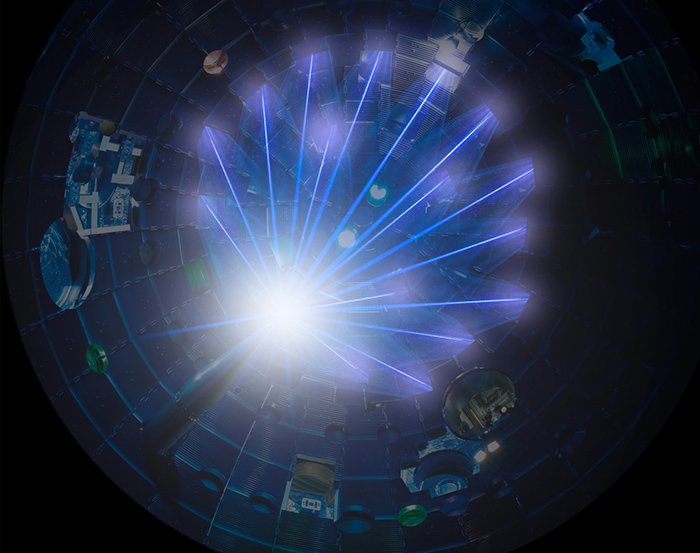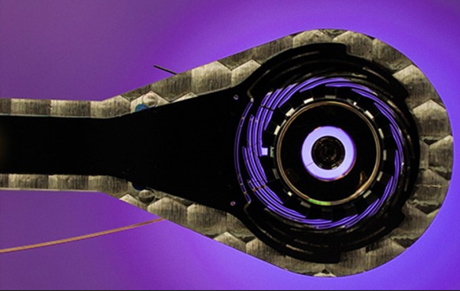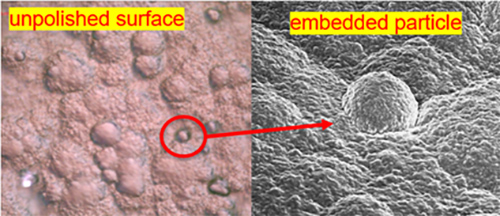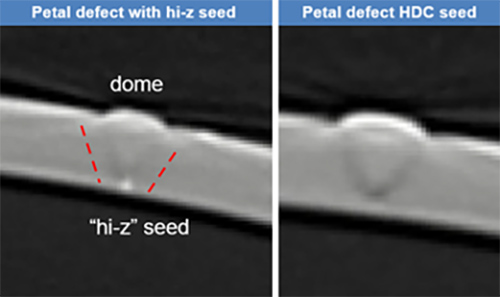High-Laser-Energy Shot Puts NIF Back on Track Toward Ignition
November 7, 2022
A record high-laser-energy NIF target shot on Sept. 19 produced about 1.2 million joules of fusion energy yield. Compared with the groundbreaking 1.35-megajoule (MJ) experiment of Aug. 8, 2021, this experiment used higher laser energy and a modified experimental design.
The accomplishment, achieved at the world’s largest and highest-energy laser system, was described in a series of presentations at last month’s annual meeting of the American Physical Society Division of Plasma Physics in Spokane, Washington.
 NIF’s 192 high-energy laser beams converge at the center of the Target Chamber to implode a tiny hydrogen fuel pellet and spark a thermonuclear fusion reaction.
NIF’s 192 high-energy laser beams converge at the center of the Target Chamber to implode a tiny hydrogen fuel pellet and spark a thermonuclear fusion reaction. Previous attempts to repeat NIF’s August 2021 shot and create a robust megajoule platform to support LLNL’s stockpile stewardship mission have been stymied in large part by effects from tiny imperfections in the targets’ high-density carbon, or diamond, capsules. While the LLNL Target Fabrication Team works to eliminate these flaws, NIF’s physics, optics, and laser teams developed an approach to make the experiments less sensitive to defects by using an increased output of the lasers to drive a thicker capsule (see “How NIF Targets Work”).
“The thicker shell design improves the hydrodynamic stability and provides more margin to ‘igniting’ the hot spot in the presence of perturbations that reduce the hot-spot energy,” said Annie Kritcher, the experiment’s lead designer. “The new design also provides higher areal density during the implosion, which is the direction we want to go in to increase the fuel burn-up fraction.”
The shot came in the wake of months of analysis of four previous repeat experiments that identified two main obstacles to NIF’s ability to replicate or surpass the Aug. 8 result.
The chief suspects: target capsule material contaminating the fusion hot spot, known as “mix,” and implosion asymmetries—both resulting in the loss of energy needed for the fusion reaction.
In the Sept. 19 experiment, laser operators boosted NIF’s laser energy from 1.92 MJ on the Aug. 8 shot to 2.08 MJ, slightly more than the researchers requested. This was the first NIF shot to deliver more than two MJ of ultraviolet energy to an inertial confinement fusion (ICF) target.
“This shot is just the beginning of a new level of ICF operations.”
—NIF Operations Manager Bruno Van Wonterghem
The shot delivered 7 percent more energy at the end of the laser pulse, increasing compression, concentrating additional energy in the target capsule’s central hot spot, and producing more fusion reactions that led to higher energy yield than the previous repeat experiments. To effectively use the extra energy and better protect the fuel from instability growth, the capsule was 8 percent thicker than the capsule used in 2021.
“The additional energy and ablator thickness was expected to make the implosion more tolerant to target imperfections and drive imbalances,” said Nino Landen, NIF’s chief high energy density scientist.
“Annie Kritcher and (lead experimentalist) Alex Zylstra deserve great credit for planning and setting up the experiment and specifying the target,” Landen said. “Preliminary analysis suggests that the current design can be further optimized to reduce symmetry degradations, potentially further increasing performance and robustness to degradations.”
NIF Operations Manager Bruno Van Wonterghem said the higher-energy shot was made possible in part by implementing several technologies to reduce debris-induced damage on NIF. These included the installation of 80 additional high-quality fused silica debris shields, for a total of 128 of NIF’s 192 beamlines, to protect the final optics from debris generated by less-expensive disposable shields. In addition, mechanical debris shielding was installed inside the laser’s lower final optics housings.
 Final optics assemblies attached to the lower hemisphere of the NIF Target Chamber.
Final optics assemblies attached to the lower hemisphere of the NIF Target Chamber. “This effort also involved a large beamline conversion campaign that took place this summer and during the August Facility Maintenance and Reconfiguration (FM&R) period,” said Tayyab Suratwala, Optics and Materials Science & Technology program director.
“The 128-beamline FSDS effort involved about a threefold increase in vendor optics supply, Advanced Mitigation Process station capacity, FSDS cleaning capacity, and FSDS storage as well as improved concept of operations,” he said. “The debris-blocking metal shields effort involved debris pathway investigation, shield design, off-line testing, NIF pilot trails, and installation during the FM&R.
“Other important achievements enabling this shot include improving uptime on the sub-nanosecond laser conditioning system, re-commissioning the crystal damage mitigation station, and improving optics cleaning processes.”
The extra laser energy and thicker target design made up for perturbations caused by a target capsule that had 20 times more high-Z (higher atomic number) contaminants, called inclusions, and 30 times more small imperfections than the 1.35-MJ target from last year.
The researchers said the experiment will further their understanding of the impact of the capsule defects and will also help guide any adjustments needed to compensate for asymmetries caused by the longer laser pulse and thicker capsule.
“This level of laser performance has been in the making for a long time,” Van Wonterghem said, “and this shot is just the beginning of a new level of ICF operations.” With additional optics improvements and laser upgrades, researchers expect NIF to reach 2.2 MJ of energy and 480 trillion watts of peak power in the coming year and potentially as much as 2.6 to 3 MJ later this decade.
Understanding the Variations
Of the four follow-up shots conducted over the past year before the Sept. 19 experiment, the best implosion, in November 2021, reached only about half the energy yield of the Aug. 8 experiment. To learn why, LLNL researchers and their partners from other ICF facilities held a series of workshops to improve their understanding of the origins of the “inherent variations” in the laser and target conditions affecting performance.
 A diamond capsule inside a NIF hohlraum.
A diamond capsule inside a NIF hohlraum. “We’ve learned that everything has to be just right in order to get one of these targets to light off and burn,” said NIF Director Doug Larson. “If anything is significantly out of spec it doesn’t work. That’s no surprise. We’ve known that for many years. The thing that has been a bit surprising is the level of perfection that’s required from the target.“
“Implosions are really effective amplifiers of pressure; that’s their primary purpose,” explained ICF Chief Scientist Omar Hurricane. “We’re trying to get more than 500 billion atmospheres of pressure—twice the pressure at the center of the sun—in the center of the implosion. But the downside is that as we try to amplify pressure, the implosion also strongly amplifies every little problem that is present in the vicinity of the capsule.
“A tiny defect on the surface of the capsule at the beginning of the implosion, barely visible, can become a gigantic jet of material plunging into the center of the capsule, the heart of the implosion, by the time we’re at peak compression,” Hurricane said.
Capsule Quality Is Key
One key to the success of last year’s 1.35-MJ experiment was the uniquely high quality of the capsule used in the shot, which contained far fewer flaws than previous—or subsequent—capsules (see “High-Quality Diamond Capsule Enhanced NIF’s Record-Energy Shot”).
“Every time you have a defect in the capsule, it potentially seeds and aggravates hydrodynamic instability,” Hurricane said. “This can become mix in its worst incarnation. So capsule quality can make our mix headaches worse.”
Capsule issues—specifically capsule wall thickness variations—also contribute to asymmetries, Hurricane said, as do energy disparities in NIF’s 192 laser beams as they enter the hohlraum. “An imbalance in those laser beams can cause an imbalance in the x-ray radiation flux that drives the implosion,” he said.
The underperformance of the repeat shots, even though they used capsules from the same batch as the Aug. 8 experiment, led members of the LLNL Target Fabrication Team to take a deeper look at the factors affecting capsule quality, such as surface holes (pits) and subsurface voids, as well as contaminating high-Z inclusions.
 Researchers believe capsule defects are most likely caused by particles embedded in the diamond during coating.
Researchers believe capsule defects are most likely caused by particles embedded in the diamond during coating. “With the second look,” said Target Fabrication Program Manager Michael Stadermann, “we now understand that there was a pretty big difference between the best (capsule) shell and several later shells.
“The first batch that we used in the (Aug. 8) shot and the repeats were head and shoulders above everything else that we’ve made afterwards, and the specific (1.35-MJ) shell was substantially better than the other shells in the first batch.”
The revised analysis revealed that the capsules used in the repeat experiments exhibited a larger number of inclusions than was previously known. Closer examination also revealed the presence on almost all newer capsule batches of “petal” defects seeded by the overcoating of debris that was embedded in the capsule during coating.  Petal defects, which have so far only been found in the target capsules’ doped layers, are suspected to affect more than 20 recent capsule batches. The petals are seeded by either high-Z or high-density carbon (HDC) material.
Petal defects, which have so far only been found in the target capsules’ doped layers, are suspected to affect more than 20 recent capsule batches. The petals are seeded by either high-Z or high-density carbon (HDC) material.
“The petals are the result of a nodule,” Stadermann said. “A nodule is what you get when you have a seed at the bottom and the diamond grows around it in a petal shape. We’ve had nodules all along; we just never saw them express themselves like this.
“Nodules ultimately cause pits and voids as well,” he said, “so what we’re going after now is the seeds of these nodules.”
Among the possible causes of seeding, he said, are abrasion as the capsules rub against each other during the coating process and debris from the decomposition of the capsule’s tungsten dopant as it’s injected into the growing shell (the capsules are doped with a small amount of tungsten to absorb x rays that could heat the fuel’s cryogenic ice layer).
‘Traveling Shells’ Make the Rounds
As a short-term solution to the capsule quality challenge, the Target Fabrication Team has developed a “traveling shells” fabrication process involving LLNL, Diamond Materials of Freiberg, Germany, and General Atomics in San Diego.
“The capsules that we’re making in Livermore do not show the same level of inclusions (as the Diamond Materials capsules),” Stadermann said, “and they don’t show any petals at all as far as we know. So we said, ‘Why don’t we make the doped layers and let Diamond Materials do the rest?’”
In this iterative process, the Livermore team uses the Lab’s diamond-coating capability to fabricate capsule shells up to the doped layer using a process called plasma-assisted chemical vapor deposition. Then they’re sent to Diamond Materials for polishing and shaping and the addition of a layer of diamond.
“I am more optimistic that we are closer to a solution than I was two months ago.”
—Target Fabrication Program Manager Michael Stadermann
The shells are returned to Livermore for cleaning and coating, they go back to Germany for another diamond layer and final polishing, and then they’re sent to General Atomics to determine their quality and to attach the tiny fill tubes used to inject hydrogen fuel into the capsules. Finally, they’re returned to Livermore for insertion into hohlraums.
“Based on the data that we’ve taken, we think those are going to be good shells,” Stadermann said. “We’re going to make a handful of batches of six or eight to have enough shells for experiments starting in early January.” For the longer term, LLNL will work with Diamond Materials on modifying their processes to improve the quality of capsules produced in Germany.
“As the story evolves,” Stadermann said, “we might discover that there are other things (of concern) and that the things that we thought were important were not quite as important. So it’s going to be a process. But I am more optimistic that we are closer to a solution than I was two months ago.”
A Framework for Progress
By studying both the results and analytic and numerical models of the repeat shots, researchers in the NIF workshops determined that the location of the observed hot-spot mix was correlated to the location of the capsule inclusions and the largest surface pits, as well as perturbations caused by the fill tubes.
They then developed a framework to relate the observed implosion asymmetry and inferred hot-spot mix to the variability in fusion yield. They concluded that if mix can be reduced to the level of the Aug. 8, 2021, experiment, repeating that shot with the current variability in the inherent laser and target asymmetry could achieve yields greater than 1 MJ in about 65 percent of future shots.
“The success of the Sept. 20 experiment was built on the hard work of all parts of the ICF program,” said Associate Program Director for ICF Science Richard Town. “It sets the stage for more robust performance and to deliver survivability data for the stockpile program in 2023.”
More Information:
“The Shape of Things to Come,” Science & Technology Review, July, 2020
“Two-Micron Fill Tubes Fill Two Needs,” NIF & Photon Science News, December, 2018
“Diamond Capsules Show Near-Term Promise,” NIF & Photon Science News, March, 2018
“Big Ideas for Tiny Targets,” Science & Technology Review, March, 2018
“Hit Me With Your Best Shot: LLNL’s Target Fabrication Team Innovates Beyond the Laboratory,” NIF & Photon Science News, March, 2018
—Charlie Osolin
Follow us on Twitter: @lasers_llnl



